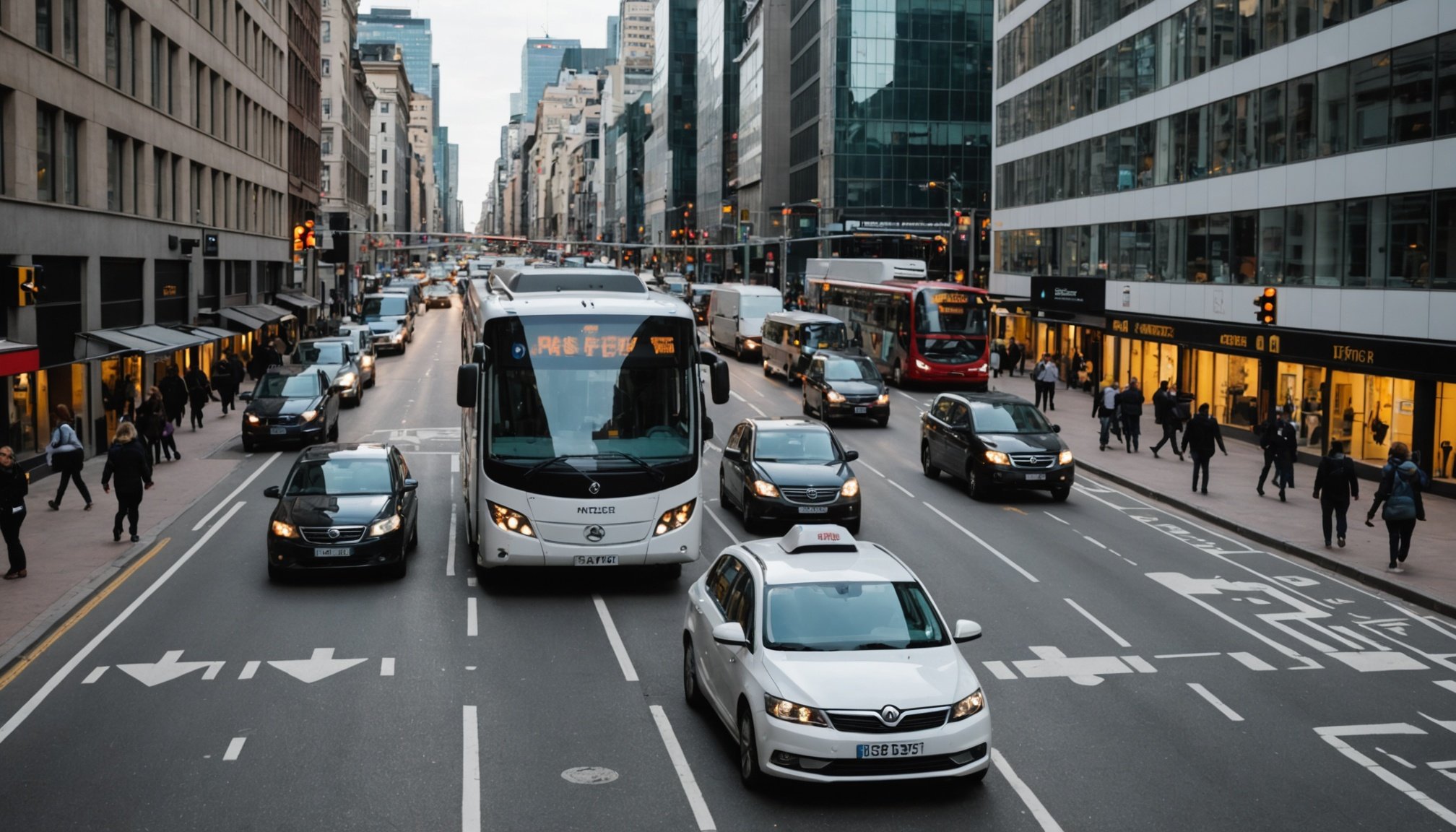Introduction to AI in Urban Traffic Management
Urban areas face significant traffic challenges, from congestion to pollution. As cities grow, these issues require efficient solutions. AI traffic management is becoming crucial to urban transport optimization. It involves leveraging artificial intelligence to improve the efficiency and sustainability of city travel through smart city initiatives.
AI traffic management refers to using AI technologies like machine learning and data analytics to predict traffic patterns, manage congestion, and optimise transportation systems. These systems can process vast amounts of data, including live traffic feeds and historical patterns, to make real-time decisions.
Topic to read : Enhancing data security: effective techniques for amplifying encryption in hybrid cloud environments
The role of AI in managing traffic is transformative. By integrating AI with existing infrastructure, cities can better control traffic flows and reduce emissions. This leads to less congestion, improved air quality, and quicker travel times. Furthermore, AI’s predictive capabilities enable proactive traffic management, anticipating problems before they occur.
Optimizing city travel is not just about convenience; it’s about sustainability. Efficient transportation systems reduce fossil fuel consumption, thereby supporting environmental goals. Cities embracing AI are setting the pace for future urban transport systems, ensuring efficient and sustainable travel for residents while maintaining a focus on innovation and environmental stewardship.
Topic to read : Revolutionizing aerospace engineering: leveraging ai for enhanced predictive maintenance solutions
AI Applications in Traffic Management
Traffic management is evolving with AI applications, enhancing how we navigate urban environments. A cornerstone of these advancements is real-time traffic monitoring. AI algorithms process vast datasets, understanding traffic flow dynamics and providing actionable insights. They analyse data from cameras, sensors, and even social media, transforming raw information into precise evaluations of current traffic conditions.
Moreover, predictive modelling is revolutionising how cities anticipate and manage congestion. By utilising historical and real-time data, AI systems predict future traffic patterns, allowing for preemptive measures. This predictive approach not only reduces congestion but also assists in improving emergency response times. Drivers, planners, and emergency services can adjust their strategies based on these predictions, leading to more efficient and safer roads.
Integration with intelligent transportation systems magnifies these benefits. AI-powered smart traffic signals adjust in response to real-time traffic conditions, optimising flow and reducing stops. Infrastructure equipped with these technologies ensures that traffic moves smoothly and efficiently, adapting to changes almost instantaneously.
These innovations signal a transformative shift in traffic management, promising smoother commutes, reduced emissions, and enhanced road safety. The future of urban mobility is undeniably interlinked with the intelligent application of AI technologies.
Case Studies of AI in Urban Settings
Exploring successful AI implementations gives us insight into urban transport innovations reshaping cities globally. Notably, cities like Singapore and Stockholm have harnessed AI for transformative traffic management improvements.
In Singapore, AI technologies manage real-time traffic data, optimising routes and reducing congestion. Autonomous vehicles and smart traffic lights exemplify AI innovations directly impacting daily commutes. Meanwhile, Stockholm’s adaptive traffic lights utilise machine learning algorithms to improve traffic flow based on predictive models.
These examples illustrate how AI technologies can enhance urban mobility. Implementing AI-driven systems has led to significant benefits:
- Reduced congestion through better traffic predictions
- Enhanced commuter experience by minimising travel delays
- Environmental gains from reduced vehicle emissions
Such case studies not only highlight AI’s potential in urban settings but also serve as models for other cities striving for efficient transport systems. They underscore the importance of tailoring AI technologies to specific urban needs, ensuring successful adaptation and utility.
Analysing these implementations shows that urban transport innovations can substantially improve quality of life, making these cities sustainably smarter and more navigable. As cities worldwide consider integrating AI technologies, these case studies provide invaluable insights into managing modern urban challenges efficiently.
Benefits of AI in Traffic Management
The integration of AI in traffic management brings substantial benefits, enhancing traffic efficiency and urban mobility improvement. Through advanced algorithms, AI monitors and controls traffic flow, reducing congestion in busy urban areas. This technology adapts to real-time conditions, intelligently adjusting traffic signals to optimise flow, leading to smoother commutes.
A major advantage includes the environmental benefits of AI. By reducing idling and stop-start driving, vehicle emissions and fuel consumption are decreased. This contributes significantly to decreasing urban air pollution and promoting more sustainable cities.
Safety also sees remarkable improvements; accident reduction is a noteworthy outcome. AI systems analyse vast amounts of data to predict and alleviate potential incidents. With machine learning, these systems can detect patterns that humans might overlook, thereby preventing mishaps before they occur.
Additionally, AI fosters better planning for future urban mobility. By analysing traffic patterns, city planners can design smarter road networks that accommodate increased populations. This forward-thinking approach not only addresses current challenges but also anticipates future demands, creating more resilient transport systems. Through these benefits, AI in traffic management plays a pivotal role in transforming urban landscapes for the better.
Challenges in Implementing AI for Traffic Management
Implementing AI in traffic management presents a multitude of challenges, starting with technological limitations and data integration issues. A primary hurdle is ensuring that the AI systems can efficiently integrate vast amounts of diverse data from cameras, sensors, and vehicles. This integration is crucial for developing real-time, adaptable traffic solutions but remains technologically demanding.
Regulatory and policy hurdles also pose significant challenges of AI. For instance, varying regulations across jurisdictions complicate the standardisation of AI systems. Policymakers must devise a cohesive framework to facilitate AI adoption, balancing between innovation and safety, which can be a lengthy process.
Moreover, public acceptance is intertwined with data privacy concerns. Individuals are often wary of how their data is used and stored. Implementing robust privacy measures and transparent policies is essential to address these data privacy concerns and foster trust. Public awareness campaigns could be instrumental in enhancing acceptance by clarifying AI’s role and the benefits it offers.
Ultimately, navigating these challenges requires collaboration between governments, technologists, and communities, ensuring AI’s integration into traffic management is both effective and ethically sound.
Future Trends in AI and Urban Traffic Management
In the realm of urban traffic management, AI is set to play a transformative role. The evolution of AI technologies in traffic systems is moving towards more autonomous and adaptive solutions. Predictions suggest a shift from reactive to predictive management, where AI anticipates traffic patterns and adjusts signals accordingly.
Emerging technologies, notably 5G and IoT, will be pivotal in enhancing AI applications. 5G’s high-speed connectivity enables real-time data transmission, essential for responsive AI systems in traffic management. Meanwhile, IoT devices can gather comprehensive traffic data, feeding AI models with rich inputs to refine their predictions and actions.
Moreover, AI has immense potential to integrate with broader urban planning initiatives for more cohesive solutions. By linking with smart city evolution projects, AI can contribute to sustainable urban developments. For instance, integrating AI with public transport systems can optimize route efficiency, reduce congestion, and support environmentally friendly practices. AI’s adaptability means it can seamlessly collaborate with other technological innovations in urban planning, offering holistic solutions to complex urban challenges. As cities grow, AI’s role in traffic management will undoubtedly expand, providing robust and efficient infrastructure enhancements.






